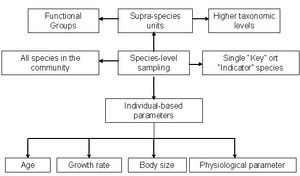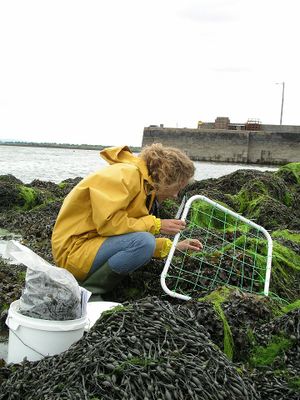Sampling
Field sampling programs provide the information needed to determine the status and dynamics of populations and communities and thus are the basis for many kind of research. The physical and biological complexity and dynamism of most marine ecosystems results in high spatial and temporal variability in almost any measured parameter. Sampling methods and procedures need to be carefully analysed and selected so as to take into account this high variability of most marine systems.
The steps in designing a field sampling program include:
- Identifying the study goals including the questions to be answered by the study or the hypothesis to be tested.
- Developing and effective and statistically powerful study design.
These steps are followed by selecting study sites, the biological units to be sampled, the sampling design, lay out, and units to be employed, and the type of data to be obtained.
Contents
Site selection
Site selection is an important decision in any sampling program and it should be based to the study objectives. Because most sampling program involves comparisons among sites, they should be physically similar in order to meaningfully compared and to avoid any confound conclusion. Some geophysical variable that have to be considered when choosing for sampling sites include: wave exposure, depth, substratum type and slope, topographical heterogeneity, salinity and the degree of human or natural perturbation. Site selection protocols should involve identifying a set of sites that are similar in terms of abiotic characteristics, and then randomly choosing a subset for study from this site pool. Additionally, sampling should be focused in on habitats of high value or to high sensitivity to suspected stressors and, if it is useful to consider trends over a large region, on habitats that are broadly present.
Biological units

The biological units targeted by a sampling program range from individual-based parameters such as the size of a particular fish species gonads, to species-level sampling such as estimation of percentage cover of all macroalgae species in a rocky shore, to higher taxonomic units such as the number of phyla. The sampling units to be selected will depend on the objectives of the sampling program and the available knowledge of the system being sampled. Ideally, the biological unit to be chosen is the most ecologically informative and known causal links with the process being studied. Sampling of the abundances or percentage cover of one or more species is one of the most common approaches of sampling programs.
Sampling Design
Two fundamental aspects of sampling design for correct inference are: randomization and replication.
Randomization is the random sampling of units in terms of temporal or spatial arrangement. In a manipulative experiment randomization is the random allocation of experimental treatments to individual units. Randomization is critical for sampling design because it makes the data more likely to be independent. The random allocation of sampling unit must ensure representativeness of the entire study area. Care must be taken that replicate samples unit are not 'segregated' in order to ensure interspersion.
Replication of sampling units within treatments or sampling sites provides a measure of variability. It is not possible to make any comparison between study sites or treatments without having appropriated replication. In addition, replication must be done at the the correct level to be able to make logical inferences. [2]
Types of sampling studies
Field sampling studies can be classified into four categories: [3]
1. Baseline studies
Data are collected to define the present state of a biological population or community. They are also called "one-off" studies, because by definition, they are not replicated in time. Results can be used to produce a record of a baseline condition prior to a given perturbation. Another goal of one-off study is to stablish a baseline for the system against which any future impact can be tested. The lack of temporal replication in baseline studies does not allow to quantify natural variability in biological parameters and, thus, to distinguish future changes from a particular stressor from those related to natural variations.
2. Impact studies
Impact studies are designed to determine the changes brought about a particular disturbance or stressor by comparing the status of natural or unimpacted biological parameters with their status under unimpacted conditions. Green’s [4] work on impact sampling design was pioneer in the development of impact assessment studies and statistical methods. Since then various authors has discuss the advantages and disadvantages of different impact study designs. [5] [6] [7] [8] [9]. Several sampling designs has been used in performing field studies to test impacts. One of the most robust and commonly used is the asymmetrical BACI design (before-after control impact design), where data are colleted on multiple occasions from both before and after an impact, usually from one impact and several controls sites.[10] [11] [12] Another commonly used sampling design is the gradient design where sites are distributed ar various distances from a central impact sites, creating a gradient and of control and impact conditions.
3. Monitoring studies
These are designed to detect any changes from the present state. By definition, monitoring studies involve repeated sampling in time. Monitoring programs in marine environments have focused on chemical, physical, and biological parameters, for example detecting microbial contamination of beaches, determining the concentration of potential harmful material on fish, estimating the population abundance of an endangered species inside a marine reserve. Some key aspects of an effective monitoring program are [13]:
- It must be carried out over a long periods and designed to account the natural variability of the system.
- It must be designed using the best available ecological concepts, study design, and principles.
- The data must be collected in a consisted and well-documented manner to achive required continuity and reliability.
- The program should be designed to detect changes and impacts based on sound statistical analyses.
4. Pattern and process (ecological) studies
These studies involve describing distribution and abundance patterns of organisms, with the intention of identifying the processes responsible for them. For this, purpose descriptive ('mensurative') and experimental approaches should be used. [14]
See also
For details of the different tools available to for sampling a range of different marine environments see:
References
- ↑ Murray SN, Ambrose RF, Dethier MN (2006) Monitoring rocky shores, Vol. University Of California Press, Berkeley and Los Angeles, California
- ↑ Hurlbert, S.H. 1984. Pseudoreplication and the design of ecological field experiments. Ecological Monographs 54: 187-211
- ↑ Kingsford M, Battershill C (1998) Studying temperate environments. Canterbury University Press, Christchurch, New Zealand, 335 pp.
- ↑ Green, R. H., 1979 Sampling design and statistical methods for environmental biologists. Wiley, New York.
- ↑ Underwood, A. J., 1991. Beyond Baci - Experimental-Designs for Detecting Human Environmental Impacts on Temporal Variations in Natural-Populations. Australian Journal of Marine and Freshwater Research 42: 569-587.
- ↑ Underwood, A. J., 1992. Beyond BACI: The detection of environmental impacts on populations in the real, but variable world. Journal of Experimental Marine Biology and Ecology 161: 145-178.
- ↑ Underwood, A. J., 1994. On Beyond BACI: Sampling Designs that Might Reliably Detect Environmental Disturbances. Ecological Applications 4: 3-15.
- ↑ Osenberg, C. W. & R. J. Schmitt, 1996. Detecting ecological impacts caused by human activities. In Schmitt, R. J. & C. W. Osenberg (eds.), Detecting ecological impacts: Concepts and applications in coastal habitats. Academic Press, San Diego: 3-16.
- ↑ Ellis, J. I. & D. C. Schneider, 1997. Evaluation of a gradient sampling design for environmental impact assessment. Environmental Monitoring and Assessment 48: 157-172.Ellis, J. I. & D. C. Schneider, 1997. Evaluation of a gradient sampling design for environmental impact assessment. Environmental Monitoring and Assessment 48: 157-172.
- ↑ Underwood, A. J., 1991. Beyond Baci - Experimental-Designs for Detecting Human Environmental Impacts on Temporal Variations in Natural-Populations. Australian Journal of Marine and Freshwater Research 42: 569-587.
- ↑ Underwood, A. J., 1992. Beyond BACI: The detection of environmental impacts on populations in the real, but variable world. Journal of Experimental Marine Biology and Ecology 161: 145-178.
- ↑ Underwood, A. J., 1994. On Beyond BACI: Sampling Designs that Might Reliably Detect Environmental Disturbances. Ecological Applications 4: 3-15.
- ↑ Murray SN, Ambrose RF, Dethier MN (2006) Monitoring rocky shores, Vol. University Of California Press, Berkeley and Los Angeles, California
- ↑ Andrew NL, Mapstone BD (1987) Sampling and the description of spatial patterns in marine ecology. Oceanography and Marine Biology: An Annual Review 25: 39-90
Please note that others may also have edited the contents of this article.
|
